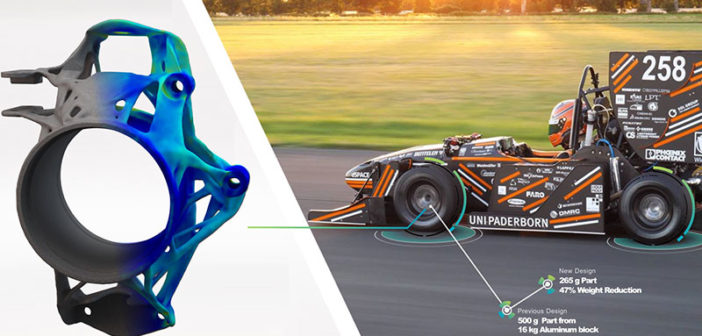Advances in generative design software and additive manufacturing (AM) technology are greatly strengthening the business case for using AM to consolidate multiple components into a single, lighter, cost-efficient and high-performance part.
For manufacturers, being able to replace 10, 15, or 25 components with one part brings obvious advantages. Not only does having fewer components simplify assembly, it helps streamline the supply chain and leads to a reduction in the use of materials. Part consolidation and additive manufacturing also combine to play an important role in light weighting, which enables aerospace and defense and automotive manufacturers to produce more fuel-efficient vehicles. And to top it all there are several examples of companies successfully consolidating parts using additive manufacturing.
So, given that deploying AM to reduce the number of components in an assembly is both possible and has demonstrable benefits, why is it not a much bigger priority for design and engineering teams?
One answer is that up until recently it has been simply too time-consuming for many teams to consider, especially when their existing design and production processes are delivering perfectly acceptable results. Consolidating parts has typically required engineering teams to decompose an assembly and work out whether it is possible to replace a collection of components that are welded, riveted or fastened together with a single moulded, forged or cast component without increasing manufacturing costs. The process can entail considerable trial and error. And that’s before anyone gets started on prototyping and testing.
Another answer is that the perceived – and too often real – complexity of additive manufacturing is a daunting obstacle for many manufacturers.
One of the many advantages of additive manufacturing is that it gives designers much greater freedom over the final part’s geometry, thereby opening up an array of new, creative ways to crack long-standing engineering problems. Rather than worry about whether a part can be produced using a casting mould or a machine tool, design engineers can harness the flexibility of 3D printing and focus on optimising the strength and functionality of a part, even if the results are unusual organic shapes.
But AM has to offer more than innovation. To make business sense AM processes have to be cost-effective, repeatable and easy to validate. The successful harnessing of additive manufacturing’s innovative potential depends on automated design workflows, embedded process knowledge, and easy-to-use software that automates and speeds up the design, production and quality assurance of additively manufactured parts.
Hexagon’s MSC Apex Generative Design, for example, simplifies the application of additive manufacturing by enabling design teams to automatically and quickly generate multiple designs. In this process it simulates how each design handles real world constraints, so that a designer can decide whether he wants the most cost-effective manufacturing, or the most sustainable design. Not only can MSC’s generative design software determine how a new design for a part will fit within the overall assembly, it can also assess how it redirects loads and merges components of the assembly as its stiffness changes. Most importantly, it shows how a single organic component can be manufactured with 3D printing, based on an automatically generated correct geometrical and mechanical design that can be used directly for manufacturing. Hexagon’s Simufact Additive and Digimat AM, meanwhile, simulates the manufacturing process and optimises the geometry for a specific production machine. Finally, Hexagon’s workflow management software and inspection solutions help to validate and deliver on the design promise. The result is a single fluid workflow that starts with a multi body simulation in MSC Adams to determine the loading conditions for generative design, and ends fully validated for usage by MSC Nastran. Thus, the full potential of additive manufacturing is realised in the form of new designs for new ideas.
Contact your local Hexagon representative to find out more about how modern generative design tools can be the starting point for streamlined. end-to-end additive manufacturing workflows, setting the basis for open, industrialised AM value chains.















